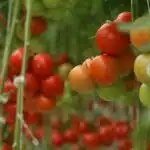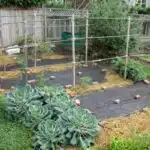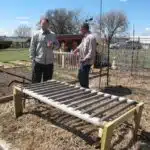Have you ever wanted to plant and grow your own tomatoes that are bursting with flavor, ready for the perfect garden salad? Tomatoes are one of the most popular vegetables grown in gardens across the country, but many people struggle to get great results. Are you curious about how to maximize your tomato growth and flavor? Read on for 10 tips for planting and growing great tomatoes, so you can enjoy a delicious harvest!
The first step in planting and growing great tomatoes is understanding the importance of healthy soil. Tomatoes require well-draining soil that is rich in organic matter if they are going to flourish. Compost or other organic material should be added to the soil before planting to ensure proper nutrition. Additionally, make sure your soil has a pH balance between 6.0 and 7.5, as this will help the tomatoes absorb nutrients from the soil more efficiently.
Finally, watering is essential for tomato plants; however, it’s important not to overwater them as this can lead to disease and fungal problems. For best results, give your tomato plants a deep soaking once per week instead of frequent shallow waterings. This will encourage deeper root growth while helping prevent diseases like blossom end rot from developing. By following these guidelines for planting and growing great tomatoes, you’ll be well on your way to a delicious harvest.
Choose The Right Variety Of Tomato
It’s almost a coincidence that the first step to planting and growing great tomatoes is to choose the right variety. As you start your tomato-growing journey, it is important to consider the space you have available and the type of tomato that would best fit in that space. Do you want a beefsteak or cherry tomato? Are you looking for something with high sugar content or one that is especially disease resistant? Knowing which variety is most suitable for your environment will help ensure success in the long run.
Once you’ve chosen your variety, it’s time to prepare the soil for planting tomatoes. To do this, make sure your soil has plenty of organic matter like compost and/or manure as well as a balance of nitrogen, phosphorus, and potassium (NPK) fertilizer. You also want to make sure there are no weeds competing with your tomatoes for nutrients and water. If needed, add amendments such as lime or gypsum to adjust pH levels and enrich soil nutrition.
Finally, be sure to water regularly throughout all stages of growth – from seedling stage through maturity – and keep an eye out for signs of pests, diseases, or nutritional deficiencies. Taking these steps will ensure your tomatoes get off on the right foot so they can reach their full potential!
Prepare The Soil For Planting Tomatoes
When it comes to growing tomatoes, over 93% of gardeners agree that proper soil preparation is essential for success. With this in mind, it’s important to understand the second step for planting and growing great tomatoes: preparing the soil.
Before you start planting your tomatoes, you should check the soil pH level and adjust as necessary. The ideal pH level for tomatoes is 6.5-7.0, so if it falls outside of this range you’ll need to add lime or sulfur to bring it back into balance. It’s also important to work some organic matter like compost or manure into the soil before planting; doing so will help improve drainage and increase nutrient availability.
Once your soil is prepped, be sure to give your tomato plants plenty of space between each other when planting; overcrowding can lead to reduced air circulation and increased disease risk. For determinate varieties, provide at least 24 inches between plants and 36 inches between rows; for indeterminate varieties, aim for 36-48 inches between plants and 48-72 inches between rows. Taking these steps will ensure that your tomatoes have enough room to thrive in their new home!
Space Tomatoes Properly
Planting tomatoes correctly can make all the difference when it comes to getting a great harvest. It’s important to ensure that you space your tomatoes properly for the best results. But what does proper spacing look like?
When it comes to spacing your tomatoes, there are several factors to consider. For example, the size of the tomato variety will affect how far apart each tomato is planted. Determinate varieties should be spaced around 12-18 inches apart from one another, while indeterminate varieties should be spaced up to 24 inches apart. Additionally, if you’re planting multiple rows of tomatoes in a garden setting, they should be placed three to four feet apart so they have enough room to spread out and receive adequate sunlight.
Additionally, take into account how much support your tomato plants need as they grow. If you plan on using cages or stakes for support, make sure there is enough room between them so that the plant’s branches don’t become intertwined during their growth process. With all these considerations in mind, it’s possible to create an ideal environment for your tomato plants before you even place them in the ground. By keeping these tips in mind and spacing your plants accordingly, you’ll be well on your way to enjoying a successful harvest of beautiful tomatoes!
Plant Tomatoes At The Right Time
Who would’ve thought that planting tomatoes at the right time could be so difficult? We often think of gardening as a simple task, but timing is everything! It turns out that when it comes to growing tomatoes, there are some specific tips one should consider for optimal success.
Believe it or not, planting tomatoes at the right time can make all the difference in the world. In order to get the most out of your tomato crop, it’s important to pay attention to climate and weather conditions. Depending on where you live and what type of tomato variety you choose, you may need to wait until temperatures reach a certain level before transplanting your tomatoes into the garden. Additionally, if you’re starting from seed indoors, it’s important to plant them several weeks before transplanting outdoors.
Whether you’re a novice or veteran gardener, understanding when to plant your tomatoes is key for successful growth and tasty fruit production. But even if you’ve got the timing down pat, there’s still more work ahead: Planting deeply will help ensure robust root systems and vigorous plants!
Plant Tomatoes Deeply
Planting tomatoes deeply is like setting the foundation for a building. It’s the essential first step in having a productive and healthy tomato crop. When planting, make sure to dig into the ground at least 8 inches and remove any large clumps of soil. This will help ensure that the plant will have plenty of room to spread out its roots and draw up nutrients from deep in the soil. Additionally, you can mix some compost or fertilizer into the bottom of the hole before planting to give your tomatoes an extra boost of nutrition. Planting deeply also helps the plant keep its moisture levels balanced, preventing blossom end rot which is caused by lack of water during dry periods.
Once planted, it’s important to set up supports for your tomatoes before they get too big. Cages are often used for this purpose as they provide strong support throughout the entire growing season. Staking is also an option but requires more maintenance as you must continually tie up and adjust them as your plants grow taller. Whichever method you choose, make sure that you do it soon after planting so that you don’t put too much stress on your tomato plant in attempting to secure it later on.
It’s hard work investing in a good foundation for your tomatoes but it pays off in spades when harvest time rolls around! With a solid start, your tomatoes should have everything they need to thrive and produce delicious fruit all summer long.
Set Up Supports For Tomatoes
Setting up supports for tomatoes is an important step to ensure successful growth and a great yield. Choosing the right kind of support is essential; options range from tomato cages, stakes, and trellises to more creative solutions like bamboo tepees and strings. All of these can be helpful depending on the variety of tomato being grown.
Tomato cages are probably the most common form of support for tomatoes, as they are easy to install and provide good stability for the plant. They come in various sizes, so make sure to choose one that will accommodate your particular variety of tomato. Stakes can also be used if you don’t want to purchase a cage or if you’re dealing with a smaller variety. When using stakes, it’s best to drive them into the ground before planting your tomatoes and then tie them securely at the top with twine or string as needed.
Trellises are often used when growing larger varieties of tomatoes since they provide plenty of space for vines to climb up. Bamboo tepees provide similar benefits but in a fun, whimsical shape! Regardless of which type of support you choose, just make sure it’s sturdy enough to hold your plants through wind and rainstorms. With the right set-up in place, you’ll be able to watch your tomatoes grow happily all season long.
Watering tomatoes regularly is key for achieving healthy growth and delicious fruit!
Water Tomatoes Regularly
It’s no secret that tomatoes need a little extra love when it comes to growing them. As the saying goes, “you reap what you sow”. This rings true with tomatoes; getting the most out of your plants requires some effort and attention. To ensure your tomato plants flourish, follow these steps starting with watering.
Watering tomatoes correctly is essential for success. The plant needs about an inch of water each week, so plan to water regularly. You can water using either a sprinkler or by hand, either works fine just make sure the soil is moistened all the way down to the roots. Additionally, avoid wetting the foliage as this can lead to fungal diseases if done too often.
Be mindful not to over-water as this can also cause problems for your plants and lead to wilting and rotting fruits. If you are unsure if your tomato plants need watering or not, stick your finger into the soil up until your first knuckle and check for moisture. If it feels dry then go ahead and give them some water!
With proper care, your tomato plants will be ready to thrive – but don’t forget about fertilizing next!
Fertilize Tomatoes Properly
It’s important to keep your tomatoes properly fertilized. Fertilizer helps provide essential nutrients to the plants, which are necessary for healthy growth and strong yields. The type of fertilizer and the amount used will depend on the soil type and what kind of tomatoes you’re growing. For example, heavy, clay-like soils will require more fertilizer than sandy soil.
When it comes to fertilizing tomatoes, it’s best to use a balanced fertilizer with equal parts nitrogen, phosphorus, and potassium (NPK). Additionally, using organic fertilizers such as manure or compost can be beneficial for tomato plants. It’s also important to make sure the fertilizer is evenly spread over the entire garden area.
Remember not to over-fertilize your tomato plants; too much can burn their roots and cause stunted growth. It’s best to apply fertilizer every two weeks or so during the growing season. This will ensure that your tomatoes stay well fed throughout their life cycle!
Control Weeds Around Tomato Plants
Weeding is an important part of tomato growing, since weeds can compete with your plants for water and nutrients. If you don’t control the weeds around your tomato plants, they could easily take over and deprive your tomatoes of the resources they need to thrive. Therefore, it’s important to keep on top of weeding in order to give your tomatoes the best chance at success.
One way to do this is by adding a layer of mulch around the base of each plant. This will help reduce weed growth by blocking sunlight from reaching the soil surface where weeds germinate. Additionally, make sure to pull any weeds that appear as soon as possible so that they don’t have a chance to set seed and spread even more weeds throughout your garden.
Lastly, if you’re having trouble controlling weeds around your tomato plants, consider using an organic herbicide like glyphosate or acetic acid. These products are designed specifically for killing weeds without harming surrounding plants or the environment. Just be sure to follow directions on the product label carefully so that you don’t accidentally damage your precious tomatoes! With these tips and tricks in mind, you’ll be able to keep your garden free of pesky weeds so that your tomatoes can grow big and strong!
Prune Tomatoes For Better Growth
Tending to tomatoes is like nurturing a pet: it requires regular attention and care in order for them to thrive. Pruning tomatoes is one such task that can help ensure their growth and health, and the tenth step of tomato growing tips is exactly this.
Similar to pruning a shrub or tree, pruning tomatoes involves removing branches or leaves that are not providing any benefit to the plant. This includes any dead or damaged branches, too-tall stems, leaves on the lower part of the plant (if they are blocking access to sunlight), as well as any suckers that have grown out of the main stem. This helps thin out the plant, which will direct energy towards more productive parts of it and allow for better air circulation.
Pruning your tomato plants can also increase their yield significantly. Removing some of its leaves allows for more sunlight to reach other areas of the plant and encourages flowers and fruits to form on its main stem instead of side shoots. Plus, taking off dead or dying parts will help prevent disease from spreading throughout the entire plant.
By following these steps in tomato pruning, you’ll be able to get your plants ready for their next step – staking them for better air circulation!
Stake Tomatoes For Better Air Circulation
Did you know that over 90% of gardeners who stake their tomato plants have bigger, juicier fruits? Staking tomatoes for better air circulation is an essential step in growing great tomatoes. It helps them to be healthier, produce more fruit, and make it easier to harvest.
Tomato plants should be staked early on in the season when they are still small. Use stakes or cages to gently support the plants as they grow and develop. This makes it easier to keep the foliage off of the ground while also allowing the leaves to spread out and get more sunlight—essential for photosynthesis! Tie the stems loosely to the stake with twine or cloth strips so that they don’t become too constricted as they grow.
Staking tomatoes also increases their exposure to air circulation which helps prevent diseases like blight from developing on the plant. It also helps reduce rot caused by wet soil splashing onto lower plant parts. Additionally, staking keeps tomato fruits off of the ground where they can be affected by pests and disease-causing fungi. All these benefits ensure a healthier crop with fewer losses due to disease and pests.
By understanding how staking tomatoes improves air circulation and reduces potential losses from pests and diseases, you now have all the info you need to get started protecting your tomato plants!
Protect Tomato Plants From Pests And Diseases
It’s important to protect tomato plants from pests and diseases. These can be prevented by regularly inspecting the plants for signs of infestation and removing any affected parts immediately. Additionally, adding mulch around the plants helps keep them safe from destructive critters. Also, using a suitable pesticide or fungicide is essential to prevent infections and other problems.
Spraying with a natural insecticide like neem oil can also help protect against any unwanted visitors. Neem oil has insect-repellent properties that can discourage bugs from getting near your tomatoes. It’s also important to take precautions when watering your tomato plants. Too much water can cause fungal diseases, while too little can lead to wilting and nutrient deficiencies.
Regular pruning helps keep the plant healthy and prevents overcrowding of new growth, which encourages disease spread. Taking these steps ensures that your tomatoes will stay healthy for many seasons to come! With proper protection in place, you’ll be able to enjoy a bountiful harvest of juicy tomatoes each year.
Harvest Tomatoes At The Proper Time
Reaping the rewards of a successful tomato growing season is just like a fisherman landing the catch of the day. It’s all about timing and preparation. Harvesting tomatoes at the proper time can be tricky, but with careful attention to detail, you’ll be sure to have a bounty of ripe fruits.
First, it’s important to check your tomatoes often to look for signs that they are ripening. The color will usually change from green to red or yellow depending on the variety. Fruits should also become softer and plump when they are ready to harvest. You may also want to lift up a few fruits gently and give them a sniff – if they smell sweet and fragrant, they’re ready!
Next, use clean garden shears or scissors to cut the stem right above the fruit so as not to damage other nearby fruits or branches. If you’re harvesting in bulk, take care not to overfill your basket as this can bruise or damage the tomatoes inside. Finally, handle your tomatoes gently during transport and store them in a cool place away from direct sunlight.
With these tips in mind, you’ll be sure to reap a delicious harvest of perfectly ripe tomatoes!
Preserve Tomatoes For Later Use
One thing is for sure, no summer is complete without a ripe, juicy tomato. With that being said, one of the best ways to ensure you have plenty of tomatoes all summer long is to preserve them for later use. To help you out, here are some steps to make it happen!
First things first, you’ll need to harvest your tomatoes at the right time. Tomatoes should be picked when they are firm and fully colored. If the tomato isn’t quite ready yet, just leave it on the vine and check back in a couple of days. Once they’re ready, pick them off the vine and set aside.
Next up comes preservation! You can either freeze or can your tomatoes depending on what you plan to do with them down the road. If freezing them, simply wash them off and cut into halves or quarters before putting into a freezer bag or container. For canning tomatoes, there are several steps involved so make sure to read up on how to do it properly.
Once done preserving your tomatoes, you’ll be able to enjoy their deliciousness all year round! Now that you’ve got that covered, it’s time to move onto replanting those tomatoes for another bumper crop come next season!
Replant Tomatoes For Another Bumper Crop
As the age-old adage goes, “The more you give, the more you will receive.” This could not be truer when it comes to replanting tomatoes for a bumper crop. Replanting tomatoes is an excellent way to ensure your garden or backyard can provide you with a great harvest for many years to come.
Replanting tomatoes involves taking the seeds from ripe fruits and preserving them for later use. Once these seeds are ready, they can be planted in well-drained soil along with plenty of compost and organic matter. In order to get the best results from this process, it’s important to make sure that the soil has been properly fertilized and prepped before planting. Additionally, make sure that plants are spaced far enough apart so that they can receive adequate sunlight throughout the day.
Finally, water your tomato plants consistently throughout their growing season and provide them with a location that is sheltered from strong winds or other inclement weather conditions. By following these tips, you will be able to reap a bumper crop of delicious tomatoes year after year!
Frequently Asked Questions
How Can I Keep My Tomatoes Safe From Animals?
Protecting your tomatoes from animals can be a difficult task, but there are some ways to keep them safe. First of all, it’s important to understand the types of animals that may be lurking in your garden and what attracts them. Knowing this information will help you come up with an effective plan.
Animals, such as birds, deer, dogs, cats, and rabbits, can all cause damage to your tomato plants if they get too close. In order to prevent them from getting into your garden and eating your tomatoes you’ll need to take some precautions. Installing a fence around your garden is one way to keep them away; it will also give you peace of mind knowing that no animal is going to get near your precious tomatoes. Additionally, using netting or row covers over the plants can provide added protection. Not only do these barriers keep animals out, but they also protect against other elements like wind and hail.
Finally, strong smells can be used as a deterrent for animals looking for food in your garden. Try planting herbs or flowers known for their strong scents around the perimeter of your garden; this will help ward off any potential intruders looking for a tasty tomato snack!
Is It Better To Buy Or Make Tomato Fertilizer?
Making your own fertilizer for tomatoes is a labor of love. It’s like a dance between the gardener and the soil, where each partner knows their steps and understands how they fit into the bigger picture. Making your own fertilizer requires dedication and patience, but it can be rewarding as you witness your tomatoes thrive under the nourishment you have provided.
So, is it better to buy or make tomato fertilizer? Like many things in life, this depends on what works best for you. If you are short on time, buying may be the easier option – although it can be more expensive in the long run. On the other hand, making your own allows you to customize the nutrients you provide to suit your specific tomato plants and give them exactly what they need.
It is important to do research before deciding which route to take – there are pros and cons to both approaches that should be considered carefully. Ultimately, whether you decide to buy or make tomato fertilizer will come down to knowing what works best for your garden and your tomatoes’ needs. With a little experimentation and dedication, either method could lead to a thriving crop of delicious tomatoes!
How Often Should I Water My Tomato Plants?
Watering your tomato plants is one of the most important aspects of growing great tomatoes. It’s essential to ensure they get the right amount of water, but how often you should be watering them can vary from plant to plant. Generally speaking, tomato plants need 1-2 inches of water a week, and it’s best to water deeply and less frequently rather than lightly and more often.
It’s important to remember that different types of tomatoes have different needs when it comes to watering. If you’re growing determinate tomatoes, you’ll want to provide more frequent deep watering as they tend to be drier. On the other hand, indeterminate tomato plants will require more consistent but less frequent watering since their soil retains moisture better.
When it comes to keeping your tomato plants healthy, there is no one size fits all approach – what works for one variety may not work for another. However, by taking into account the individual needs of your particular type of tomato and providing adequate water, you should be able to ensure that your plants get just the right amount they need in order to grow great tomatoes!
Is It Possible To Grow Tomatoes In A Pot?
Growing tomatoes in a pot is possible, but it comes with some challenges. For example, the pot needs to be able to hold enough soil and have good drainage. Additionally, the size of the pot will determine how many plants can fit in it and how much water they need. Lastly, the type of tomato you choose should be appropriate for the size of your pot.
When growing tomatoes in a pot, there are certain things to consider that you wouldn’t need to worry about when planting in the ground. First, make sure your pot has enough drainage holes to prevent waterlogging. Second, use a quality soil mix or compost for optimal growth. Third, ensure your container receives at least six hours of sunlight each day. Finally, fertilize regularly with an organic fertilizer to keep your plants healthy and producing lots of fruit.
Tomato plants grown in pots require more frequent watering than those planted in the ground since their roots are confined within the container. When it’s time to water, check the soil for moisture before doing so; if it’s still wet from your last watering session then wait until it dries out before providing more moisture. Additionally, be sure not to overwater as this can lead to root rot and other diseases that can damage your tomato plants.
What Is The Best Way To Store Tomatoes For Future Use?
When it comes to storing tomatoes for future use, there are a few key things to keep in mind. First, tomatoes should be stored in a cool, dry place without direct sunlight. This is because the sunlight can cause them to spoil faster. Secondly, tomatoes should be stored on their stems and not cut until immediately before using. This helps preserve their flavor and texture better than if they were cut ahead of time. Lastly, once you’ve cut the tomato, any remaining unused portion should be wrapped tightly in plastic or aluminum foil and stored in the refrigerator.
It’s important to remember that although these storage methods may help keep tomatoes fresh for longer, they won’t last forever. Eventually, even the best-stored tomatoes will go bad so it’s important to try and use them as soon as possible after purchasing or harvesting them. Additionally, if you’re planning on saving your tomatoes for future use, make sure that you only select those which are ripe but still firm enough for storage.
Once you have picked out your ideal tomatoes for storage, take care to make sure that they are properly stored so that you can enjoy their delicious taste later down the road!
Conclusion
Tomatoes are one of the most delicious, versatile, and rewarding fruits to grow. With a few simple tips, you can have a garden full of ripe, juicy tomatoes in no time.
For starters, make sure that your tomatoes are protected from animals by using fencing and netting. Determine whether it’s better to buy or make your own fertilizer, and water regularly to ensure the health of your plants. If you’re short on space or want to try something different, consider growing your tomatoes in pots. Finally, use proper storage techniques such as freezing or dehydrating to save your bounty for future use.
By following these tips, you’ll be able to create an abundant tomato harvest that is sure to delight all year round. Whether you enjoy them fresh off the vine or preserved for later enjoyment, tomatoes will bring joy with every bite! So get planting and start reaping the rewards of homegrown tomatoes today!





























